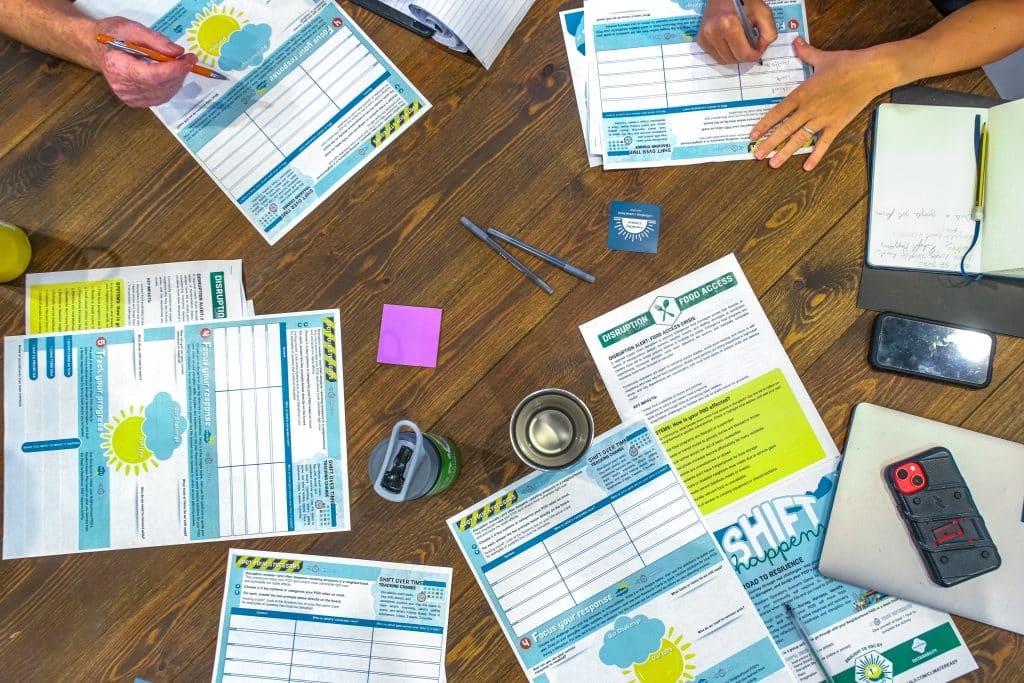
Editor’s Note: ‘No Spurs No’ is a series about the proposed new San Antonio Spurs arena and downtown development vision known as Project Marvel—and the many critical efforts more deserving of our attention for their ability to help us survive this time of colliding crises.
Imagine things breaking down. It’s tragically easy to do.
In the span of just a few years, most of us have experienced the floor being ripped from beneath our feet at least once. From the COVID-19 global pandemic, arriving in 2020, came the 2021 winter storm that very nearly collapsed Texas’s electrical grid. Just two years later, we fastwalked into the furnace that was the hottest summer in the state’s history, living through another crash course in disaster as global heat rises to predictable result. Then came this past June’s flash floods sweeping folks off the roadways in Northeast SA, followed the very next month by a climate-strengthened “rain bomb” over Kerr County that washed away more than 130 lives this summer.
Related: “San Antonio Leaders Dangerously Bedazzled by Project Marvel Amidst Climate Breakdown“
So when facilitators of last month’s climate disaster preparedness convening challenged a half dozen small groups to imagine the onset of climate shock, it was really a matter of choosing which kind of climate shock. Extreme heat? Arctic weather surging across the state? Power loss? Disruption of the food supply?
Cheekily titled “Shift Happens,” the gathering opened with an admission: in the heat of crisis, government is almost never the immediate source of our security. That happens at home, or very close to it.
“We have more climate impacts hitting us more frequently, and more extreme climate impacts,” said Kate Jaceldo, the City of San Antonio Office of Sustainability’s climate adaptation manager. “Because we know that it can take a minute for the government to respond, the more we can be prepared … at the neighborhood level, the better off we are.”
The SA Climate Ready Neighborhoods program, a burgeoning effort in partnership with the local nonprofit Impact Guild, seeks to activate “pods” across the city, neighborhood by neighborhood, teaching the power of interdependence at the level of the city block. It’s considered one of the most innovative climate programs in the state today. Yet in the midst of broader funding reductions, including at the Office of Sustainability, the program’s funding is being stripped away.
Meanwhile, an alternative vision for the city, the multi-billion dollar downtown redevelopment vision known as “Project Marvel” with a new San Antonio Spurs stadium at its heart, is advancing with the support of boosters in media, elected office, and a range of financial interests. As Deceleration wrote last week in an opinion column kicking off this series, Project Marvel is monopolizing our attention at a time of colliding ecological and political crises when our attention (and investment) is desperately needed elsewhere.
While some boosters will surely profit directly from realization of the effort, most notably Spurs Sports & Entertainment, many of the project’s core supporters have embraced Marvel more selflessly as a tool for community well being. By their logic, subsidizing wealth creation for those at the top within the urban core will trickle out over time to those at the periphery.
A competing vision of community well being—a vision pursued by many, I would learn, gathered that day inside the San Antonio Mennonite Church on the edge of San Antonio’s Southtown—is found at the level of the neighborhood. More specifically, Climate Ready Neighborhoods promotes neighborhood-scale resilience by strengthening the social and ecological fabric of community.
Huddled around small tables in groups of four and five, participants were asked to take stock of what they had on hand: their skills and those of their immediate neighbors, the tools in their garages, as well as their relationships—anything that might be useful for neighborhood-scale responses to sudden climate disruption.
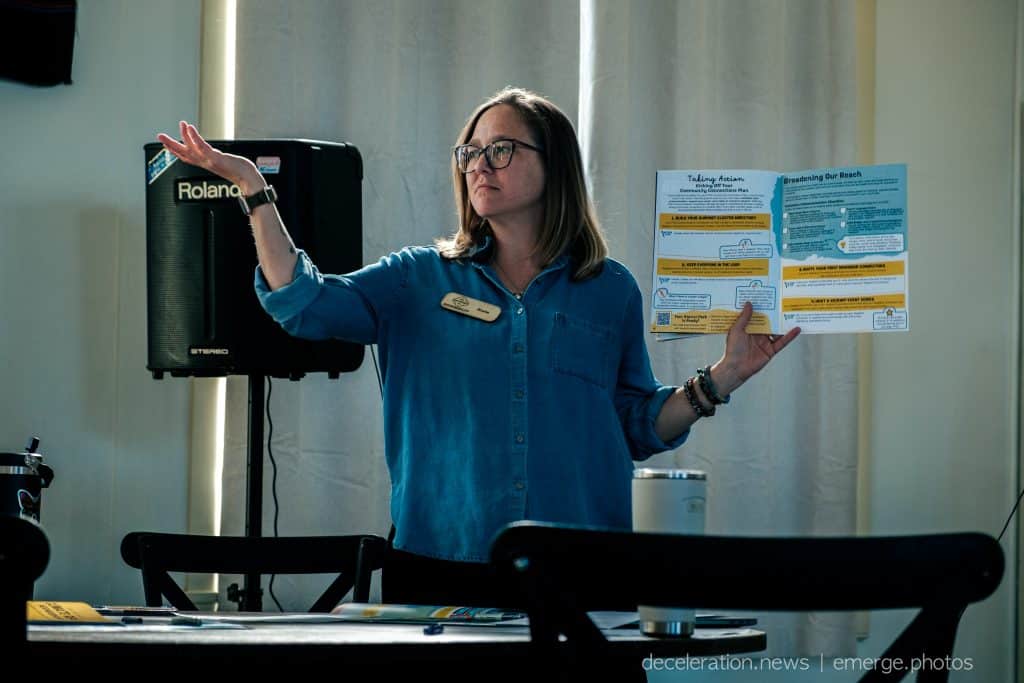
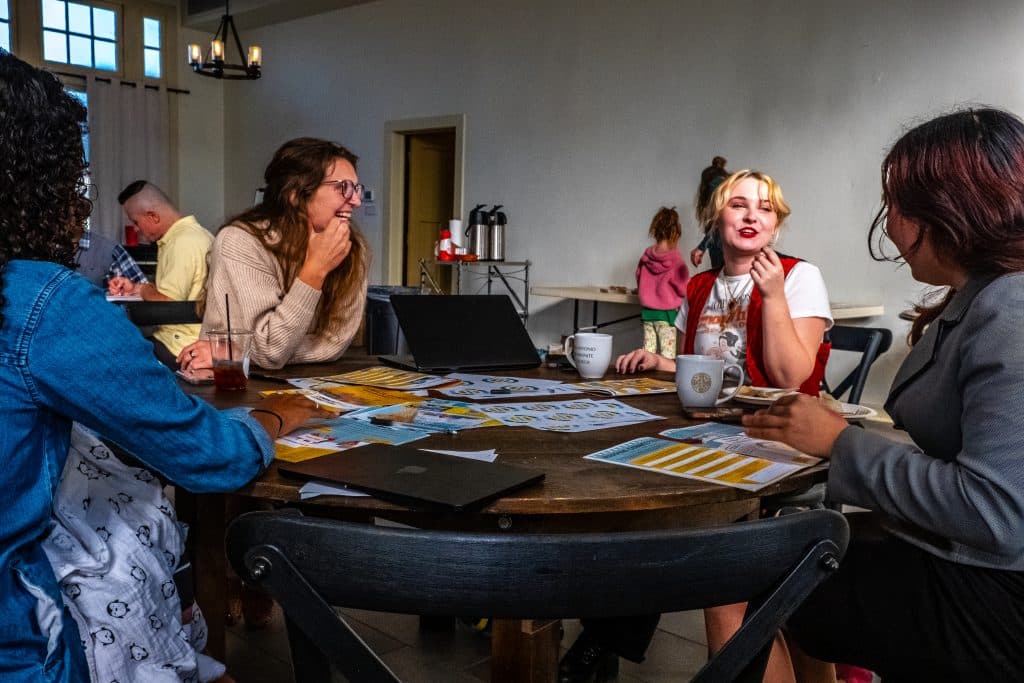
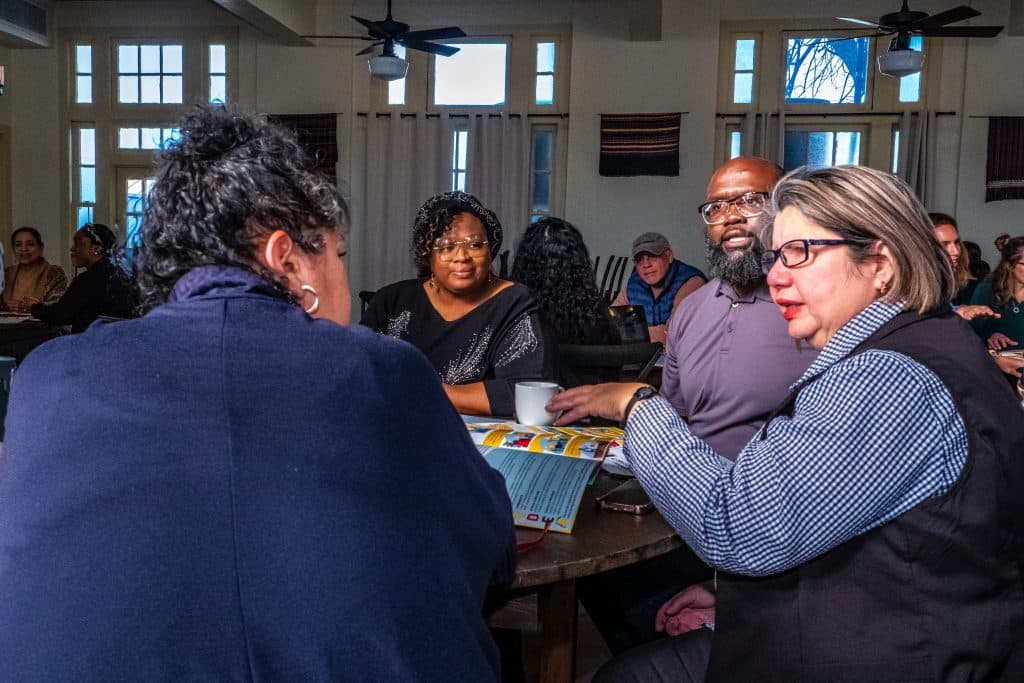
While extreme heat and cold were possible scenarios to game out, our table chose a disruption to the food supply. We quickly agreed that while our communities are often pretty good at springing together in response to short-term emergencies, we weren’t so confident about shortages that may endure beyond a couple weeks.
Seated across the table from me, Bill said he wasn’t concerned about his block’s ability to withstand a sharp climate shock. In his more affluent Northwest-side neighborhood, he said most have deep and well-stocked pantries. Many also have home generators. “Many of us are former military and we’re used to carrying generators with us,” he said.
But Bill admitted that sharing with neighbors in a time of crisis may prove complicated.
With food reserves threatened, he said, even his well-prepared and largely affluent neighborhood over time would probably fracture with the strong and better resourced dominating the weaker and less prepared. Writ large at the level of a city or state, this sort of social breakdown would mean hoarding, violence, theft or worse.
To my right sat a local artist named Megan Harrison. She identified social atomization as one of our primary threats and proposed a unique response. “I’ve thought a great art project would be around front porch furniture,” Harrison said. “I see developers building all these homes in town with porch swings and chairs but never anyone using them.”
For increasing segments of our cities, porch furnishings evince a cultural memory of relationships that, in the midst of a rampant loneliness epidemic, people no longer actually experience. The breakdown of these in-person community ties has decimated cities from within in the span of just a few generations.
Funded by a modest City arts grant, Harrison hoped to interrupt that isolation in a small way with an environmental art project next year. She planned to guide her neighbors in Northeast San Antonio, who share a unique sliver of Texas Blackland Prairie—known to ecologists as the continent’s “most endangered” ecosystem—in harvesting local clay and constructing artifacts to integrate into an art show that would reproduce that iconic front porch.
“Solutions to develop more connected neighborhoods are often proposed at the level of government policy and zoning—a realm where private interests hold great sway, and individuals are often disempowered,” she wrote in a grant application to the City for the effort. “My research and art will focus on actions initiated by individuals or small groups that carve out places for meaningful connection.”
While bonds and shared identities that transcend partisan politics are critical in this moment—including those that come from hometown pride in sports teams like the Spurs—scholars of the “polycrisis” frequently point to the need for re-forging forms of identity built around our shared reliance upon the lands, waters, and atmospheres that sustain us, the kind of land-based identities at the root of so many Indigenous and tribal lifeways.
Understanding our relationship to place and neighbors as a kind of “bioregioning” or even “Earth democracy,” as articulated by activist-scholar Vandana Shiva, can not only provide an alternative to the ethnonationalist appeals central to far-right authoritarianism, but can radically ramp up activism on behalf of the planet, resulting in rapid policy gains.
Discussion of disaster preparedness frequently spins out in two directions: that of the individual or family “prepper” and “bug out” bags at one end, and large-scale governmental disaster response on the other. Yet, increasingly, as Climate Ready has been modeling for over a year, it is the local—the level of the neighborhood—that is being increasingly understood as the critical determinant of survival (ie. “survival of the sociable”).
Of course, neighbors and friends have long formed informal mutual aid groups to meet needs that governments often miss, ignore, cause, or compound. Earlier this summer, I was invited to join a house meeting on the West Side not many blocks outside the shadow of Bexar County Jail. This group gathered out of frustration with watching housed and unhoused neighbors succumb to heat illness and heat-related death. They were equally frustrated with policing approaches that pushed those most in need into jails or other increasingly risky landscapes (such as creeks and urban flood-control infrastructure) rather than housing and healthcare. With only the resources each attendee had on hand, this group of mutualistas taught each other about the impact of extreme heat on the human body and how to identify and intervene in heat illness and heat stroke.
I left with a gifted jar of local honey and better informed about what to do if I see someone unresponsive, overwhelmed by the heat or a possible drug overdose (or a combination of both). It was more information than I’ve ever received at any governmental gathering. And there were now two bottles of potentially lifesaving Narcan in my bag to boot.
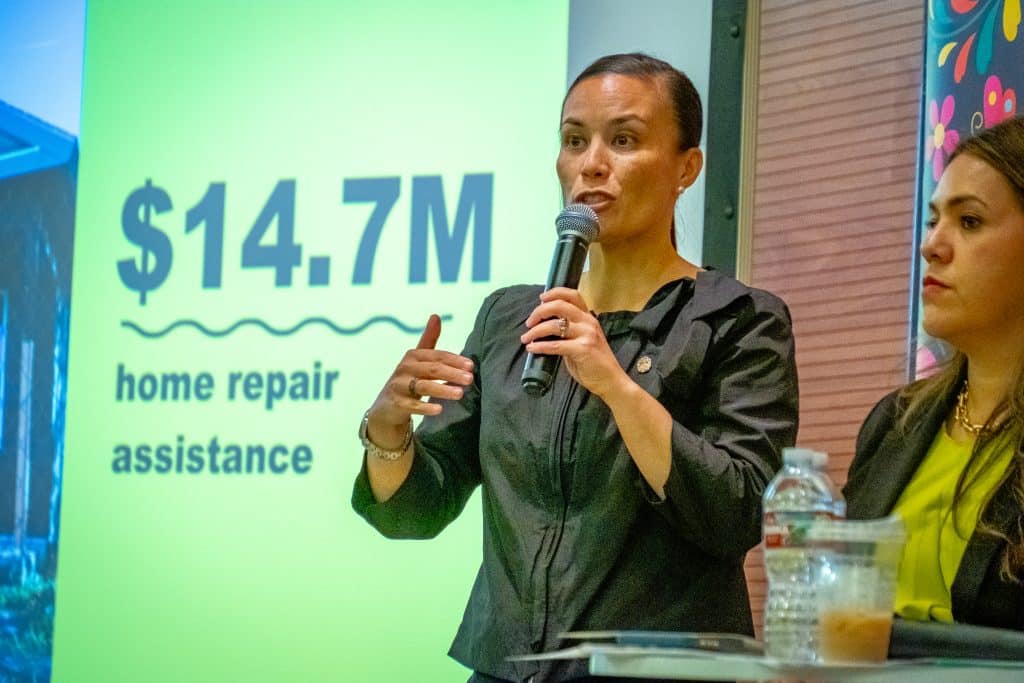
While one of the lesser-funded City departments, the Office of Sustainability has still been able to move millions of dollars into a variety of community spaces via microgrants. The Climate Ready Neighborhood program has been funded through the Resiliency, Energy Efficiency, and Sustainability (REES) Fund established in 2022 and championed by former District 7 councilmember Ana Sandoval. It was the City’s first such fund, drawn from City-owned CPS Energy revenues earmarked specifically for community resilience efforts.
Within the span of two years, however, the fund was raided by City Manager Erik Walsh to fill gaps in contract promises to emergency responders. While the funding change will go into effect this coming budget cycle, the Climate Ready Neighborhoods work will draw forward 2025 dollars to fund efforts into the coming fiscal year, a staffer shared with me on background. However, a growing part of climate adaptation manager Jaceldo’s work going forward now must be dedicated to seeking out new funding sources if the program is to exist in 2027.
Overall, REES funds are being reduced from about $21M per year over the last two years to $10.3M in FY2026. Reductions include funds previously used for resiliency hubs and construction of shade structures at city bus stops. The Office of Sustainability’s budget is being reduced from $5M set aside in 2025 to $3.2M now reserved for fiscal year 2026.
By comparison, the City of Austin has increased funding for climate and sustainability efforts, Environment Texas writes. And the City of Dallas has also increased funding for its Office of Environmental Quality and Sustainability from $5.3M to $5.6 while moving 50 sustainability staff into other departments to help guide operations there, writes The Dallas Morning News.
For context, the San Antonio’s Police Department will draw down $660M from San Antonio’s general fund under the proposed $4B 2026 budget and add more than 50 officers. A vote on the budget is expected September 18, 2025.
A budget session on the Northside of San Antonio was frontloaded with questions by recently elected Councilmember Ivalis Meza Gonzalez, reflecting what she described as residents’ primary concerns of “public safety, public safety, public safety.”
“Safety” in this context clearly did not mean what it did for “Shift Happens” participants inside the Mennonite Church. There was no mention of heat or cold shocks, spiraling temperatures or rising humidity driven by the burning of fossil fuels and global deforestation. And there was no update on the city’s contribution to all of the above.
First up for discussion were illegally parked or idling 18-wheelers. Then mailbox break-ins and car thefts. The timing of road construction projects followed, before questions about a possible splashpad were raised. It wasn’t until 40 minutes into the meeting that Meza passed the mic to Mayor Gina Ortiz Jones, who let the room know she was requesting that the City Manager Walsh report back on the potential impact of the coming collapse of social services due to MAGA’s war on public health. It’s an issue that Bexar County Commissioner Tommy Calvert and Councilmember Teri Castillo also raised in alarm this May.
According to Jones, a former Under Secretary of the Air Force, the budget must first fund what she described as “no-fail missions,” including police, fire, and EMS, while minimizing impact on the most vulnerable communities.
“I asked in particular Metro Health, an entity that is already underfunded, what would you do with more resources?” Jones told those assembled. “Because as we go into a timeframe where we’re seeing cuts to those that are already most vulnerable, the thing that keeps me up at night is public health and how we are able to surveil that, understand who is impacted, and how we respond in light of not only the changes but the information and disinformation around public health that we are already experiencing.”
Lastly, Jones spoke of looking for long-term impacts from cuts. “We don’t want to cut our nose off to spite our face, save the five bucks today if that counts us 20 bucks down the road.”
At the Office of Sustainability, spirits aren’t high. “Basically we all get to keep our jobs,” said one staffer speaking on background. But employment is a low bar when the programs that avert suffering and give their work meaning are being unwound.
Deceleration reached out to Mayor Jones but did not receive a response. Chief Sustainability Officer Doug Melnick likewise did not respond to a request for comment before Deceleration‘s press deadline.
Beyond San Antonio, cities across the U.S. are reeling from the Trump Administration’s clawback of a variety of funds that had been helping power climate initiatives and the transition to cleaner energy sources. At the federal level, Trump is also eradicating key elements of our knowledge of planetary change by closing observatories and crashing satellites that track climate emissions.
It’s unclear how communities will respond as climate destabilization escalates and our forecasting abilities are intentionally crippled. But the growing threats have inspired scientists to emphasize adaptation efforts on an overheating planet, efforts that have often followed cries for curtailing emission of greenhouse gases, so-called “mitigation” strategies. (More on this in our next installment.)
Yet whether adaptation or mitigation, technical responses alone may no longer suffice, writes one of the leading thinkers in the field of spiritual ecology, Dr. Leslie Sponsel.
“Ultimately secular approaches have proven insufficient because they ignore the fact that the environmental crisis as a whole is actually a spiritual and moral crisis, and that it can only be resolved by radical transformations in the ways that industrial capitalist societies relate to nature,” Sponsel wrote in 2019 in the Oxford Research Encyclopedia of Religion.
“All of this is pointing toward the necessity of far greener lifestyles and societies, not just sustainability, but a profound reorientation in the place of humans in nature. Either appropriate changes will be cultivated voluntarily, or they will be forced on humanity at far greater economic, social, and political costs with enormous human suffering.”
As the direct hits from those climate shocks impact more people, tolerance for old forms of development wear increasingly thin—enough for even die-hard fans to break from their hometown sports teams.
Said one resident ahead of the City Council vote that moved conversations for the $1.3B Spurs arena to the negotiating table without the benefit of Mayor Jones’s sought-after independent financial review:
“I really used to love the Spurs. Now every time I think about them they leave a sour taste in my mouth. So I’ll call them the San Antonio Sours.”


